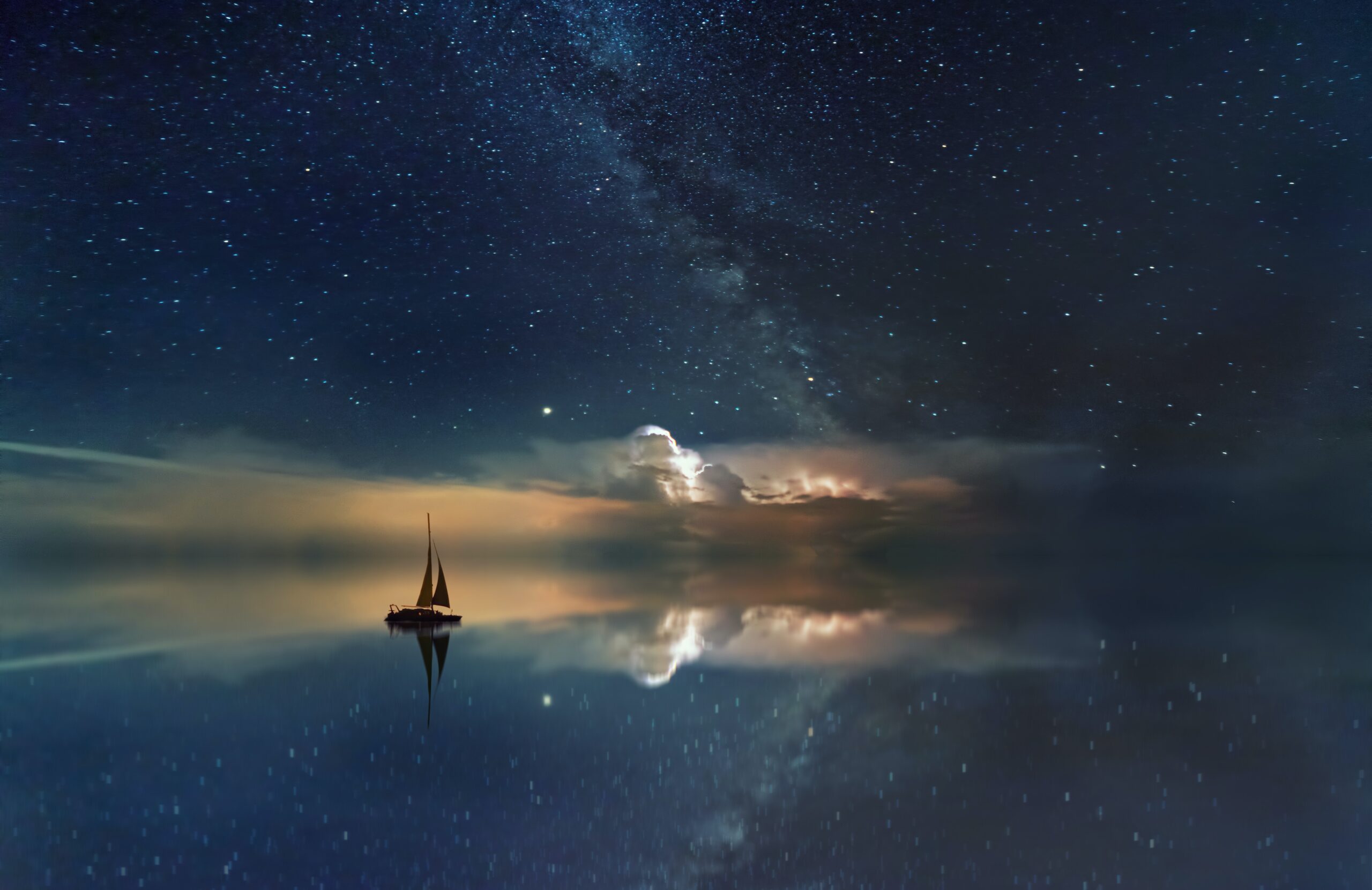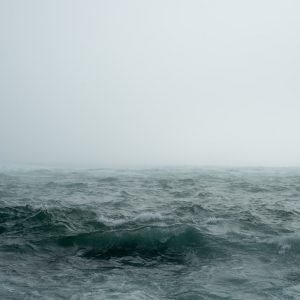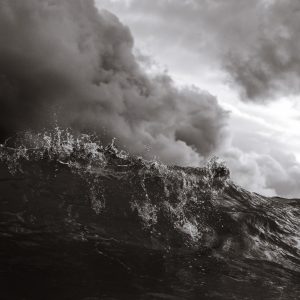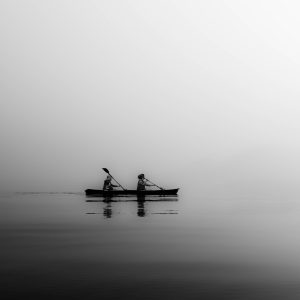On a ship full of women, clashes of personality are to be expected. I knew from the day we set out from Thyborøn that my crewmates harboured doubts. They whispered unkind words about me – that I had the captain’s ear, that I was mærkelig, whatever that meant – but I tried not to listen. I knew they spoke only out of fear, for what sea-woman does not fear the unknown?
We sailed past Stavanger and out into the North Sea. Then came my own home islands, which from a distance, I saw as flattened, unremarkable lumps of green. They appeared unreal to me, insubstantial, like lily pads afloat on a pond. It was strange to think that these islands were once a bastion of industry, a stronghold for the whalers of old. That was back when it was deemed safe for men to sail the seas, of course. These days, few Shetlanders answer the ocean’s call. Marooned on their islands, the men and boys tend to livestock while the women fish, trade, or uproot to the mainland in search of work.
“That your home?” said Chief Mate Bille, surprising me as I stood at the rail. “Don’t look like much. Is barely bigger than Bornholm.”
“It’s where I grew up,” I replied. “I haven’t lived there for a long time now.”
“You left for work?” Bille asked in her strangely accented English.
“For work, yes,” I said. In a way, it was true.
That night, in my sleep, I saw Ida. Her face floated just out of reach, her chocolate-brown eyes shining like coins through the water. I could no longer picture her face when I was awake. Asleep, though, my memory was undimmed, and she was perfect. I woke praying in a garble of tongues, my hands snatching at the hot, diesel-tinged air of the cabin. As the sweat dried on my skin, I reminded myself that I was here, that this was really happening, that finally, after all these years, I was doing what needed to be done.
#
Cape Farewell was four days away. During the long, featureless passage through late summer seas, I kept to the bridge, assisting Captain Møller where I could, observing and holding my tongue where I couldn’t. Captain Møller was firm rather than friendly, fair rather than kind, but I appreciated her tolerance. If she was diffident towards me, she was equally so towards the rest of the crew, to whom she showed neither loyalty nor favouritism. She barked at the others for muttering under their breath and chastised them at mealtimes when they neglected to pass me the serving spoon or the plastic bucket of bread rolls.
There were two harpooneers – Madsen and Larsen – both young, athletic, sharp-toothed, and keen for blood. They wore shorts and loose vests, which exposed their muscles to the sun, and they spent hours in the gym below decks, where they took turns goading each other on the weights bench. As the voyage progressed, they piled on layers, sheathing their quads with insulated leggings and stretching knitwear out of shape over their broad shoulders.
On my way to the shower one morning, I collided with Madsen emerging from the gym, stripped to her underwear. She leered at me in the dim, unnatural light. With one elbow, she nudged me out of her way. “Lille pige,” she whispered as the doorframe met my spine. Little girl.
From someone my own age, I might have let it pass. But Madsen was young enough to be my daughter.
“Careful, Madsen,” I said, almost too low for her to hear over the rumble of the engines. “If you keep acting like a man, you’ll hear the song one day. And then you’ll drown yourself in the sea.”
She turned and looked at me. Her expression was blank, stupid, but her gaze was sharp. An iceberg can look slow and harmless from a distance before its unseen extremities cut you to shreds below the water. I continued into the shower room and locked the door.
#
Bille sat next to me at breakfast. In her yellow deck overalls, she looked big and bear-like, a cartoon character in an oilskin hat. “You see this thing before?” she asked me through a mouthful of oatmeal.
The others at the table slowed their conversations, trying to listen in.
“I’ve tracked it before,” I replied.
“Where? The north?”
“Off Shetland.”
“It’s as big as the captain says?”
The table was silent now. All ears focused on Bille’s question. Of course, it was the one thing they wanted to know.
“Fifty barrels,” I said. “Easily. Maybe even sixty.”
Breath blew out into the overcooked air around us.
“But have you seen it?” Bille insisted, her oatmeal spoon jittering.
“With my own eyes,” I said, which, again, was not exactly a lie.
In truth, there was still a part of me that was afraid to speak of it. Even now, when I was closer than ever before to locating my quarry, some obscure superstition made me reluctant to form the words. For over a decade, I had roamed the globe, searching out folk tales and scientific wisdom alike, unable to impart to anyone what I knew I had seen one morning off the coast of my home island. I didn’t even tell the police at the time; I knew they wouldn’t believe me. Ida had been kidnapped, they decided, months later, when her little corpse failed to wash up on any of the neighbouring beaches. Some criminal, some child-snatcher, had chanced upon her that morning and whisked her away.
But I knew what I had seen.
I dedicated myself to the study of these creatures. I logged their mating habits, mapped their migrations, hunted them through cold waters and warm, always searching for proof that I was not mad, that what I had seen was real. Their size, I learned, is proportional to the temperature of their native seas. Around the equator, they are so small you could hold one in your hand, but as fast as darting insects. In Cape Verde, they grow to almost the size of a human, and the islands there abound with stories of men – and not only men – enticed away underwater by the lure of their song. But the biggest specimens, those reared in the coldest regions of the world, are so massive that they can traverse oceans. The great leviathans of the Antarctic have long been hunted for their oil. And for vengeance, of course. A single creature off the coast of Argentina once enticed an entire village of men to plunge to their deaths, entrancing them with her song so that they swam willingly into her open jaws. The women of the village took to their boats. They pursued the creature for three days and nights and harpooned her. They still display her bones on the harbourfront to this day.
In Greenland, the locals have their own myths. They believe that the monsters cannot, or must not, be killed; that the balance of their environment depends upon it. From Nanortalik to Qaanaaq, I listened to tales of the Qalupalik, the half-human sea-monster who snatches children from the shoreline and drags them beneath the water, never to be seen again. A fairy story, intended to scare errant children, nothing more. Or so I thought.
#
It took us two days to round the Cape, as we were walled in by an unfortunate mass of early pack-ice. It began as tiny, bird-sized bergs, which jostled on the water like swans. These increased in number over the next few hours, until the hull of the Malereq was forced to carve a channel between the close-packed floes. Møller cut our speed, and we inched grimly around the point. We were wary of storms and of the descent of fog, for this cape was a famous graveyard, its seabed encrusted with frozen wrecks. The weather held, though. We headed up through the Davis Strait and into Baffin Bay.
For the rest of the crew, this was a time of inactivity. Madsen and Larsen hung by the rail like starved dogs, itching for the hunt. Any seals foolish enough to approach the hull were shot and butchered. The Danes stored their skins and ate their blubber in soft white strips while the noses of their disbelieving comrades bobbed and vanished between the floes.
I, however, had work to do. For the first time on this voyage, I had become indispensable. Møller and I pored over my notes: migratory charts, anatomical diagrams, data logged throughout my years of research. I let my obsession rise to the fore and consume my every waking thought. In the dream-like, endless daylight of the far north, I worked without regard for time, for time seemed no longer to exist. The cook, Mose, came to find me on the bridge at one point with a bowl of reheated stew. She informed me, somewhat apologetically, that it was past midnight. I looked at the ice-bright daylight outside and wondered if I was going mad.
Towards the end of our second day in Baffin Bay, we encountered a thick bank of fog which halted us in place for several hours. Møller hung over her instruments as though paralyzed, her eyes glued to the sonar screens, waiting for some monstrous iceberg to sail out of the fog and plough our hull into splinters. She sent the crew out on deck. Their bulked-out shapes moved indistinctly below us as they laboured, chipping away with hammers at the creeping, cobwebbing ice the fog’s breath formed on every surface. When at last, the fog cleared, I had fallen asleep in my chair, my forehead pressed into a bathymetric map of the bay.
The call went up not long before midnight. Hassing was on lookout at the foremast. “White water!”
“Where away?” shouted the Second Mate, Egeberg.
“Flukes!” came the answering cry from Hassing. “Flukes off the starboard bow!”
I ran out on the deck and reached starboard just in time to see the tailfin plunging back below the water. The size of it took my breath away. It was wider across than the length of a hunting boat. She must be eighty feet long, I thought wildly. Eighty-five, even. A monster.
“Madsen! Larsen!” barked the Captain’s voice in my earpiece. “Did you get a reading?”
“Madsen here,” came the reply. “Heading under to the northwest. She should surface two miles north-west, estimated twenty minutes.”
“Twenty?” yelled Larsen, who sounded like she was running. “Are you sure?”
“She’s a giant,” Madsen shouted back.
“I have her on sonar,” said Captain Møller. “Standby to lower boats.”
I could hear Larsen whooping in my ear as the teams made for the boats. The ship had two hunting boats; one hung over the hull on each side. It took the Danes little more than three minutes to load the boats and lower them into the water. In that time, we had lost ground as the Malereq slowed so as not to spook the quarry. Bille and Egeberg started their engines and sheared away through the water. The harpooneers were poised at their cannons, which were mounted to the decks of the hunting boats. They trained their eyes on the patch of ice-swarmed sea to the northwest, where the creature was predicted to rise.
In the old days, of course, all of this was done purely by estimation, and not infrequently, a hunting boat would find itself propelled into the air on the vast shoulders of its prey. Modern technology allowed for greater accuracy. Captain Møller, viewing the creature’s progress on her sonar screen, could pinpoint the likely surface spot.
“Speed up,” she barked over the comms. “You’re going to miss her. She’s going a little over four knots, starting to rise now.”
“Four knots?” Larsen yelped.
I clung to the rail, transfixed. Adrenaline surged up my neck. In all my years of accompanying hunting expeditions, I had never grown accustomed to the speed of it, the violence, the horror of seeing a living creature slaughtered. That vast green tail swept again before my mind’s eye. She was so huge. So alien.
The thought of the grenade-tipped harpoon exploding inside her flesh made my stomach swim.
Once she was dead, they would haul her up the enlarged chute into the hold and try her out, as the whalers of old called it. This process of trying out, or flensing, involved stripping the subcutaneous blubber, a curiously solid substance that could be observed to sparkle in the moonlight, and extracting the raw oil from the creature’s sounding cavity, the source of her deadly sea-song. The blubber would be stored in refrigerated containers, the oil in barrels, ready to be shipped to the refinery. They would then hack the scales from the huge, muscular tail. The larger ones were as hard as diamonds and worth their weight in gold. The smallest scales, found at the joint where tail meets fin, would be trimmed down and incorporated into jewellery.
Madsen’s voice rang again in my ear. “White water!”
From my vantage at the rail, I could make out the froth of an impending breach. The surface ahead of the hunting boats boiled into a whirlpool. She was going fast, much too fast.
“Hold off!” I yelled into my microphone. “She’s breaching!”
They had barely time to alter their course. Bille and Egeberg hauled on the tillers with all their strength as the sea churned and foamed. The huge head of the creature broke the surface between the two boats and kept on rising.
My breath stopped.
Massive, blubbered shoulders, smoothed almost flat by the thickness of flesh around her neck, burst from the water and powered skywards, followed by her flipper-like arms. The huge body towered over the boats, which looked in that moment, like toys bobbing in bathwater. The creature lifted her entire length free of the surface. She was enormous. Impossible. A giant. The green scales of her tail glinted and sparkled in the light as she soared in a massive arc, seemed to hover for an instant, and plunged down once more into the water.
I had never seen anything more magnificent in my life.
I stood shuddering on the icy deck, my skin prickling, my eyes wide with wonder. It took a moment for the screaming in my ears to register. Both the hunting boats had capsized. Red lifejackets bobbed by their upturned sides.
“Women overboard!” Egeberg roared. “We have injuries.”
Even through my earpiece, I could hear that her voice was shaking with cold. In these temperatures, shock can paralyse a person in seconds. We all wore drysuits under our clothes, but even so, nobody could survive the Arctic Ocean for long.
Møller said, “Launching rescue boat.”
“She’s heading straight for us!” screamed Bille.
Beyond her, a snake of ice was forming on the surface. Displacing waves across her enormous shoulders, the creature propelled herself through the water at an unbelievable speed. The wreckage of the hunting boats and the red lifejackets washed helplessly aside in her wake. She wasn’t coming for them. She was coming for the Malereq. There was no time to react, to change course. I stood and watched the ice dividing into white waves.
BOOM.
The deck shook. My hands met the rail; I fell to my knees. I didn’t understand what was happening.
“Engineers!” Møller was shouting. “What’s the damage below?”
I couldn’t hear the reply. My earpiece was filled with sounds: screaming, splintering, the rushing of water. In panic, I tore my headset off.
The ship was listing. My ankles twisted as the deck sloped beneath my feet. I clung to the rail, staring down at the frozen seawater. This couldn’t be happening. For a mermaid to attack a ship was simply unheard of. For a ship to sustain damage – an ice-class vessel, no less, with its reinforced double hull – was unthinkable.
BOOM.
This time I fell to the deck. Cold saltwater splashed around me and into my eyes. Women in yellow overalls were running past me, shouting in obscure voices in a language I couldn’t seem to understand. I concentrated on regaining my balance. Using the icy metal of the rail, I pulled myself to my feet. The monster was swinging round again, carving huge waves which crashed down like walls onto the bobbing dots of lifejackets. I tried to imagine the force of that water. It would feel like a giant fist crushing down from above, sending the life-jacketed bodies spinning helplessly into the freezing blackness below.
She was coming for the ship again. She emitted an unearthly roar, a sound of madness, a sound from the depths of the ocean.
I turned and began to stumble along the deck. I didn’t know where I was going or to what purpose. If the ship went down, out here in this forsaken place, this cemetery of icebergs, we would all die. My blind instinct to survive kept me moving, still clinging to the rail. My gloved hands moved frantically, my feet skidded and slipped, but I had nowhere to go.
That was when I heard the calf.
At first, I did not know what I was hearing. I groped for my headset, thinking my earpiece was damaged, forgetting that I had thrown it aside. The sound strengthened, resolving into a strange, piercing music that rose all around me. I twisted my neck, half-paralyzed. The beauty of the song arrested my senses. I could still distantly hear the roaring of the monster, the screams, and shouts of my crewmates, but an aura of peace had all at once stolen over me. It was as though the rest of the world were far away.
I looked over the rail.
She was floating a little distance away, the curve of her white back barely distinguishable among the ice floes. She was about half the length of a hunting boat. Her skin was marbled, angel-white, her tail a pale sage-green, not yet having attained the brilliant lustre of adult scales. But it was her eyes that froze me to the core. The large, round, chocolate-brown eyes.
She bobbed momentarily, looking up at me, singing to me. Then, with an inviting tilt of her long head, she slipped beneath the surface. Water distorted her face. For a moment, she was a monster, a vision from my nightmares. The next instant, she was herself again: childlike, somehow untouched by our many years apart. Her brown eyes winked through their ice-proof membrane.
It was impossible. It couldn’t be her.
And yet, I knew what I had seen. Just as on that desolate morning twelve years ago, when my child slipped into the sea in the wake of a huge, ice-white creature whose green tail swept the length of the bay, I had to trust the evidence of my own eyes.
Ida.
She had been stolen away from me, taken by the monster, the Qalupalik, and transformed into a creature of the sea. All these years I had searched for her, and I knew now that her song was meant for my ears alone.
In that moment, it was clear why a person might lose their mind for that song. Why they would let themself sink into the depths, the cold forgotten, their need for air forgotten, their only wish to drift down there in white darkness for eternity.
Was I dreaming? Was I already dead? I felt no longer able to trust the evidence of my senses. My eyes, my ears; the logical, scientifically capable mind that had enabled me to track these creatures, to learn their habits, to hunt them to this desolate place at the edge of the world; all of it became unreal to me. It didn’t matter to me if I died. It didn’t matter if we all died or if we all became monsters, green-finned and ice-bound, roaming eternally beneath the sea. It mattered only that she was there. At last, I had found her.
The battle fell away behind me. With the song still soaring in my ears and filling my limitless heart, I climbed onto the rail, balanced there a moment, and let my body fall.




